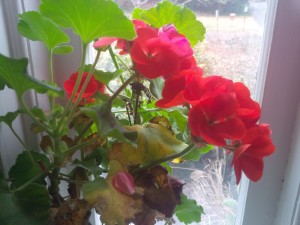 The sunniest spot on my dining room window seat is currently occupied by a geranium—Pelargonium x hortorum–that is struggling to come to terms with the winter light. By the time it truly acclimates, it will probably be March—almost time to take it outdoors to soak up the direct sunshine it craves. In the meantime, it has sprouted one brave bloom, a tribute to the tenacity of a hybrid plant whose species ancestors emigrated from far-off South Africa.
The sunniest spot on my dining room window seat is currently occupied by a geranium—Pelargonium x hortorum–that is struggling to come to terms with the winter light. By the time it truly acclimates, it will probably be March—almost time to take it outdoors to soak up the direct sunshine it craves. In the meantime, it has sprouted one brave bloom, a tribute to the tenacity of a hybrid plant whose species ancestors emigrated from far-off South Africa.
Those geranium forbears were not alone. South Africa is a cradle of botanical diversity, without which we ornamental gardeners would be considerably poorer. If you have ever grown, arranged, or admired gerbera daisies, gladioli, black-eyed Susan vine, bird-of-paradise, or agapanthus, you have experienced a plant that literally traces its roots back to South Africa. Some sources estimate that about ten percent of the world’s flowering plant species are native to that country.
One southern South African area in particular has been recognized for its unique natural value. Since 2004, the Cape Floral Region has been one of the United Nations Education, Scientific and Cultural Organization’s World Heritage Sites. According to UNESCO, the area was awarded this designation because it is “…one of the richest areas for plants when compared to any similar sized area in the world. It represents less than 0.5% of the area of Africa but is home to nearly 20% of the continent’s flora. The outstanding diversity, density and endemism of the flora are among the highest worldwide.”
Many of the best-known South African plants are part of the enormous daisy or Compositae family. Because of this geographic and family connection, a number of them go by the nickname “African daisy”, and it can be hard to sort them out. Among the most popular is the colorful gerbera or Transvaal daisy, a florists’ favorite and stalwart of perennial gardens in warm winter climates. Treated elsewhere as annuals, modern hybrid gerberas come in an array of bright colors, with large single daisies born atop tall stems.
Another tender perennial, hybrid arctotis, features somewhat narrower petals than gerbera, but sports an equally cheerful color range, often highlighted by dramatic black or blue-black centers. Its relative, gazania, sometimes called the Namaqua daisy, after its native Namaqualand region of South Africa and Namibia, appears often in modern gardens. Treated as a bedding plant in cold-winter areas, gazania is even shorter than arctotis, topping out at about 12 inches. Though gazania is available in a range of colors, I like the variety with gold petals highlighted by brown-maroon central stripes.
While not a true daisy, delosperma or ice plant is a low-growing South African succulent with daisy-like flowers in bright colors. Never rising above six inches, the plants will form a ground-covering mat, given generous amounts of direct sun and very well-drained soil. Delosperma can allegedly survive in climates up to and including USDA plant hardiness zone 6, where average annual extreme winter temperatures might go as low as zero. I would not bet money on this survival, but for a really beautiful ice plant, I might risk planting in a protected spot with lots of winter mulch.
But what if you are sick of winter’s grayness and can’t yet think about a vivid summer garden full of South African daisies? Take heart, because with a few computer keystrokes or a trip to the nearest decent garden center, you can lay hands on a clivia in short order. This South African amaryllis relative sprouts the same tall stems and long, strap-like leaves as other amaryllids, but instead of extremely large individual trumpets, it produces clusters of somewhat smaller blooms. The most common flower color is bright orange, but yellows are also available for slightly more money. Clivia is a winter bloomer, and given a modicum of thoughtful care, it will rebloom, year after year. I invested in a yellow-flowered clivia at last year’s Philadelphia Flower Show. I am hoping that it will bloom after the holidays to keep my lonely geranium company.
Someday, if the stars align themselves properly, I would love to go to the Cape Floral Region and see all those gorgeous flowering plants. In the meantime, I am thinking of my personal floral region and making plans to add a few more arctotis and delospermum to next summer’s garden. A small helping of South Africa’s floral diversity will go a long way towards satisfying my appetite for garden color.
